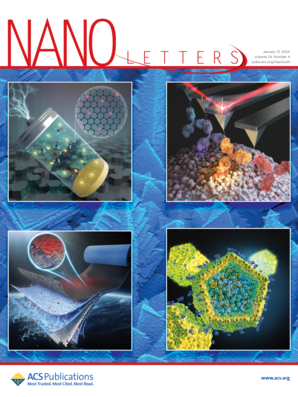用于材料识别的无线无源柔性射频触觉传感器
IF 9.6
1区 材料科学
Q1 CHEMISTRY, MULTIDISCIPLINARY
引用次数: 0
摘要
开发用于感知真实世界的智能触觉系统对于电子皮肤和可穿戴设备具有重要意义。然而,避免复杂的电路和实现轻量化和无线触觉设备仍然具有挑战性。本研究提出了一种仿生、超灵敏、多功能无线射频触觉传感器(WiRFTS),它由多孔聚苯胺-聚二甲基硅氧烷(PANI-PDMS)海绵、压力电极和通信线圈组成。得益于多孔结构和高介电PANI粒子的协同效应,WiRFTS具有1.394 MHz/kPa (<10 kPa)的超高灵敏度、0.319 MHz/kPa (10 - 200 kPa)的线性灵敏度和0.28%的高分辨率。特别是,WiRFTS表面的电磁场使其具有特殊的空间感知能力。将WiRFTS与人工智能算法相结合,建立非接触式智能材料认知系统,对8种材料的识别准确率达到100%。对基于射频的介电特性的广泛研究确保了该系统在材料识别多样性方面优于其他技术。本文章由计算机程序翻译,如有差异,请以英文原文为准。

Wireless Passive Flexible Radio Frequency Tactile Sensor for Material Recognition
Developing intelligent tactile systems for perceiving the real world is significant for electronic skin and wearable devices. However, avoiding complex circuitry and achieving lightweight and wireless tactile devices remain challenging. This study presents a biomimetic, ultrasensitive, and multifunctional wireless radio frequency tactile sensor (WiRFTS), which comprises a porous polyaniline–polydimethylsiloxane (PANI–PDMS) sponge, pressure electrodes, and a communication coil. Benefiting from the synergistic effect of the porous microstructure and the high dielectric PANI particles, the WiRFTS exhibits an ultrahigh sensitivity of 1.394 MHz/kPa (<10 kPa), a linear sensitivity of 0.319 MHz/kPa (10–200 kPa), and a high resolution of 0.28%. Especially, the electromagnetic field at the surface of WiRFTS endows it with exceptional spatial perception. A noncontact intelligent material cognition system is established by combining WiRFTS with artificial intelligence algorithms, achieving 100% recognition accuracy for eight materials. Extensive study of RF-based dielectric properties ensures the system surpasses other technologies in material identification diversity.
求助全文
通过发布文献求助,成功后即可免费获取论文全文。
去求助
来源期刊

Nano Letters
工程技术-材料科学:综合
CiteScore
16.80
自引率
2.80%
发文量
1182
审稿时长
1.4 months
期刊介绍:
Nano Letters serves as a dynamic platform for promptly disseminating original results in fundamental, applied, and emerging research across all facets of nanoscience and nanotechnology. A pivotal criterion for inclusion within Nano Letters is the convergence of at least two different areas or disciplines, ensuring a rich interdisciplinary scope. The journal is dedicated to fostering exploration in diverse areas, including:
- Experimental and theoretical findings on physical, chemical, and biological phenomena at the nanoscale
- Synthesis, characterization, and processing of organic, inorganic, polymer, and hybrid nanomaterials through physical, chemical, and biological methodologies
- Modeling and simulation of synthetic, assembly, and interaction processes
- Realization of integrated nanostructures and nano-engineered devices exhibiting advanced performance
- Applications of nanoscale materials in living and environmental systems
Nano Letters is committed to advancing and showcasing groundbreaking research that intersects various domains, fostering innovation and collaboration in the ever-evolving field of nanoscience and nanotechnology.
 求助内容:
求助内容: 应助结果提醒方式:
应助结果提醒方式:


